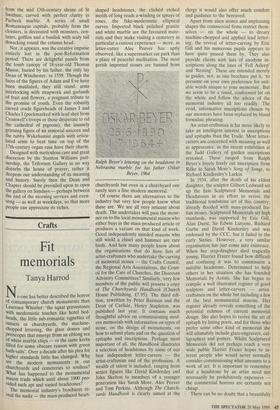Museums
Triforium Gallery (The Cathedral, Winchester)
Magnificent fragments
Celina Fox
There was a telling juxtaposition of photographs in the recent retrospective held at the RIBA Heinz Gallery on the work of the architect designer Alan Irvine. In 1968 and 1975, he designed Treasuries for two of our cathedrals, Winchester and Christ Church, Oxford respectively, who were then awakening to the potential of increased tourism as a means of contribut- ing towards their daunting repair bills. In each setting, Irvine produced elegant streamlined showcases using high-quality materials in keeping with the contents, and these showcases are still in use. But as a more recent photograph reveals, at Christ Church the cathedral authorities have seen
Spandrel with the figure of a monk in Purbeck marble, c.1260 fit to introduce a shop into the 12th- century Chapter House where the Treas- ury is situated, so that Irvine's original clarity of concept is blighted by racks for postcards, souvenir guides and teeshirts.
The problem of paying for the upkeep of our ecclesiastical heritage is, as we are constantly reminded, far from solved. But to its (we hope) eternal credit, Winchester has chosen another route from that of sales on or off the premises. With grants from the European Commission, the English Tourist Board, Hampshire County Council and its own diocesan charities, the Dean and Chapter have opened a gallery of mediaeval and post-mediaeval art in the triforium of the cathedral's south transept. For a £1 entrance fee, the visitor climbs the narrow stairs to a gallery with glorious views up and down the nave. Within this inspired setting, beautifully lit in tactfully austere vertical cases of Portland stone, glass and steel, some of the most miracu- lously preserved sculpture in the country can be seen.
It is extraordinary difficult today to comprehend the impact made by the visita- tion of Thomas Cromwell's men in the early hours of 21 September 1538 to plunder the shrine of St Swithun, which had provided the focus for people's devo- tion for 400 years. With what horror the city must have watched its cathedral being stripped of all ornament and imagery, the eyes of statues gouged out and the torsos hacked up for use as building blocks or hard core. But as repair and reconstruction works were undertaken within the pre- cincts during the 19th century, fragments gradually came to light once more. The most remarkable group pertains to the high altar screen, erected in the late 15th century and thus within a generation of those who witnessed its desecration. .A series of sculptured heads and a single fist are all that survive from a programme of 18 full-scale images of kings and bishops. Yet each still retains an individual force, a pared-down boldness of characterisation which suggests that the sculptor was in touch with wider currents of European humanism — the Italy of Donatello and Mantegna, the Germany of Adam Kraft. The seated figure of the Virgin and Child still bears traces of the pigments that must have made it as splendid as the polychrome altarpieces of Veit Stoss. This quality is not isolated: Winchester was embellished by generations of crafts- men of the highest calibre. A series of late 14th-century figures from a reredos of the Guardian Angels Chapel (one clearly iden- tifiable as St John the Baptist dressed in camel-skin with the camel's head resting between his feet) possesses the linear grace of international Gothic at its finest. From William of Wykeham's Chantry Chapel come two life-sized heads of queens,
with
the serene foreheads, almond eyes and beatific smiles of Gandhara Buddhas. The figures of a monk and a bishop survive from the mid 13th-century shrine of St Swithun, carved with perfect clarity in Purbeck marble. A series of small Romanesque capitals, probably from the cloisters, is decorated with monsters, cen- taurs, griffins and a basilisk with scaly tail thwacking round the column head.
Nor, it appears, was the creative impulse entirely lost in the post-Reformation period. There are delightful panels from the tomb canopy of 18-year-old Thomas Mason, buried by his father, the only lay Dean of Winchester, in 1559. Though the faces of the figures of Adam and Eve have been mutilated, they still stand, arms interlocking with strapwork and garlands of fruit and flowers, a poignant tribute to the promise of youth. Even the robustly carved crude figureheads of James I and Charles I (pockmarked with lead shot from Cromwell's troops or those desperate to rid the cathedral of pigeons), the insanely grinning figure of an armorial unicorn and the tubby Wykehamist angels with articu- lated arms to beat time on top of the 17th-century organ case have their charm.
Designed with meticulous care and great discretion by the Stanton Williams part- nership, the Triforium Gallery in no way disturbs the house of prayer; rather it deepens our understanding of its meaning and history. Surely then the Dean and Chapter should be prevailed upon to open the gallery on Sundays — perhaps between the end of the morning services and even- song — as well as weekdays, so that more People can appreciate its riches.



































































 Previous page
Previous page